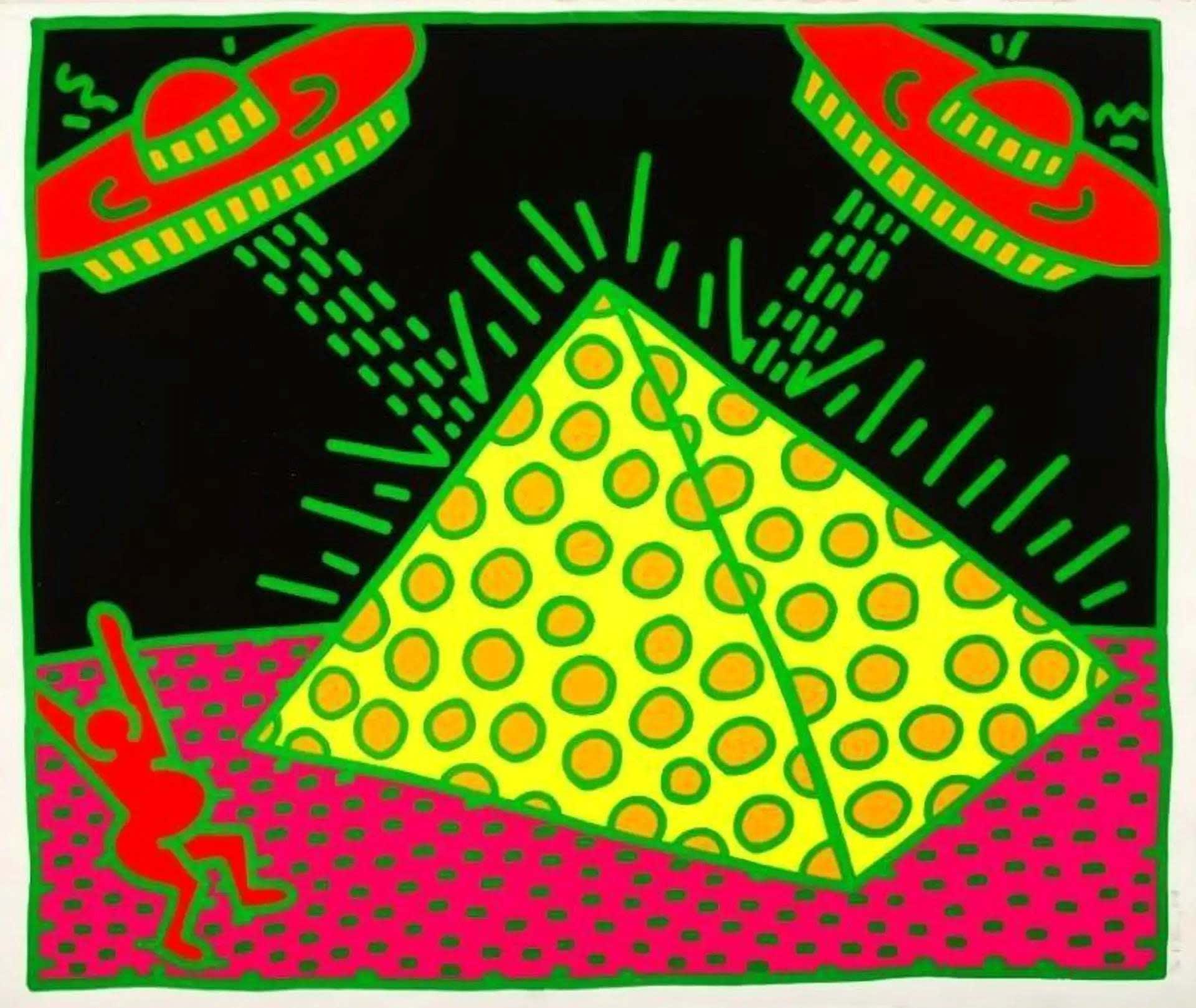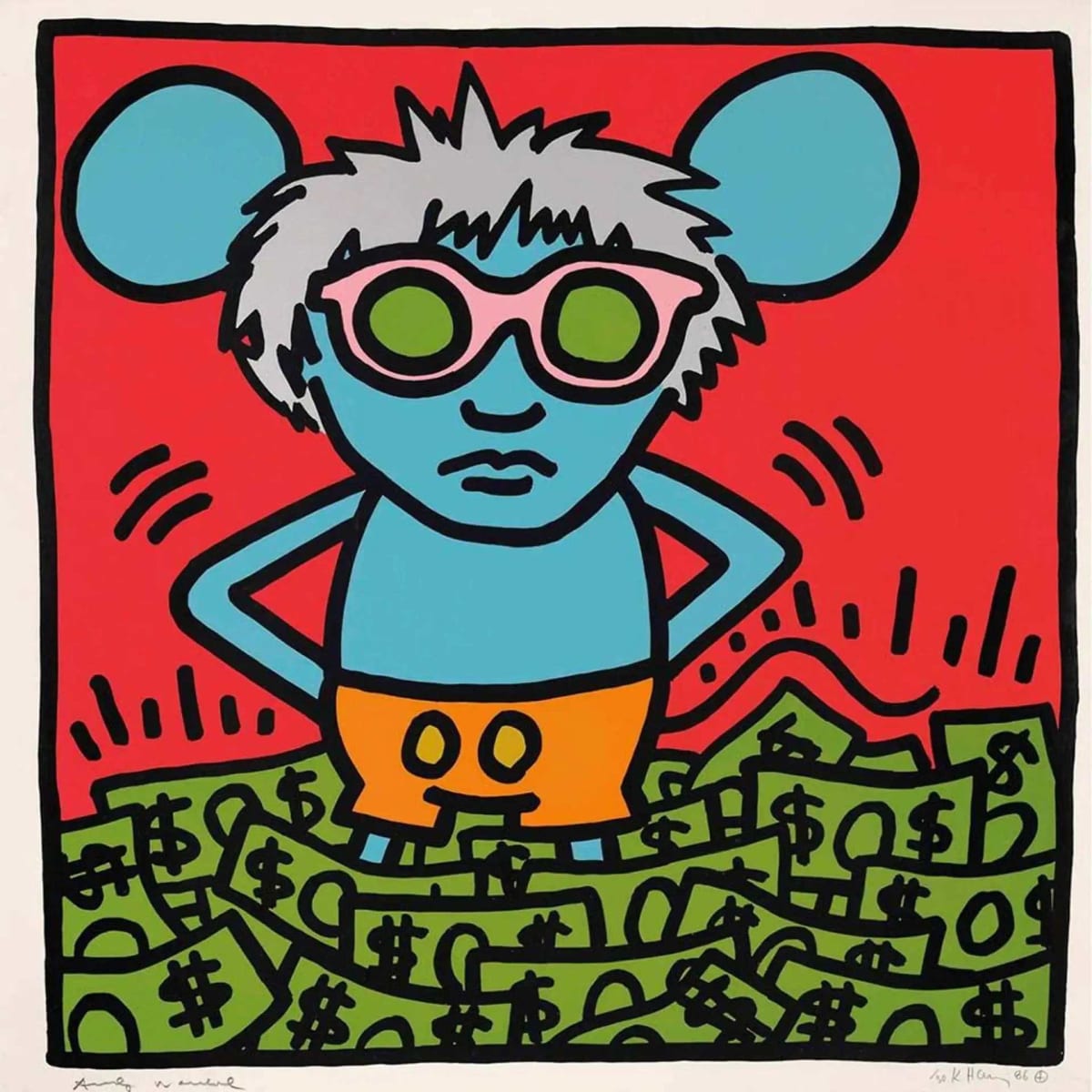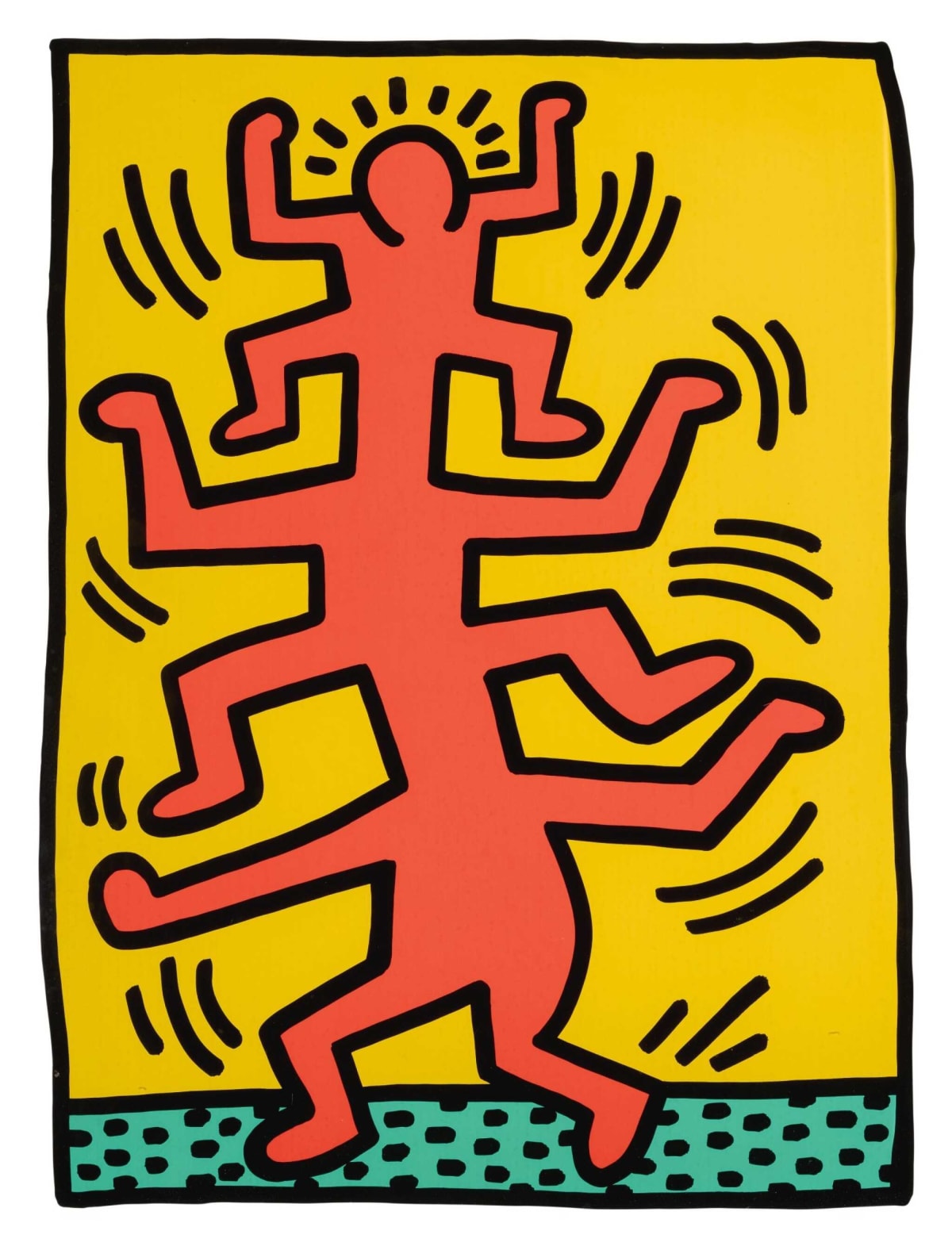
Fertility Suite
In 1983, Keith Haring, renowned for his iconic and instantly recognisable art, created a powerful portfolio of five screenprints titled "Untitled 1-5," collectively known as the "Fertility Suite" series. This remarkable collection delves into the pressing issue of the HIV epidemic in Sub-Saharan Africa, shedding light on a complex problem that, at the time, was shrouded in stigma and received inadequate attention. The sheer vibrance and magnitude of each print in the series reframed this crucial issue, securing Haring's reputation not only as an artist but also as a social and political activist.
The "Fertility Suite" reimagines Haring's signature matchstick figures, typically devoid of facial features, each bearing a protruding pregnant belly. These figures engage in prayer and dance, evoking a sense of ritualistic significance. In the first plate of the series, four women extend their arms toward a baby floating in the sky. This floating infant, often referred to as Haring's "Radiant Baby," is a recurring motif in the artist's work. It symbolises the purest and most positive form of human existence—children, who embody life's simplicity and joy. However, in this iteration, the Radiant Baby is tragically marred by the perils of HIV transmission during pregnancy, represented by the green spots that cover the child's form, symbolising disease and infection.
In the second plate, another quintessential Haring icon emerges—the UFO. Two extraterrestrial spacecraft hover above a pyramid adorned with the same green spots. Once again, a pregnant woman stands, arms raised in supplication. Haring juxtaposes the ancient and the otherworldly in this composition, blurring the lines between earthly and celestial. While the narrative remains somewhat ambiguous, it conveys the idea that the pregnant woman is at the mercy of an alien power, seeking guidance and salvation from above, both literally and metaphorically. The use of black, yellow, and pink panels adds an ominous and foreboding dimension to the artwork.
Plates three to five in the series depict Haring's iconic matchstick figures on a grand scale, resembling gigantic and god-like beings. Their interpretation is multifaceted—they can be seen as fertility deities or representations of the disease itself. In plate four, two pregnant women with touching palms are embraced by a central figure bearing an abdomen shaped like an ankh. This same ankh-shaped abdomen reappears in the final plate, where a towering figure is upheld by five smaller pregnant figures. The ankh, an ancient Egyptian symbol signifying life and the power to bestow it, serves to emphasise the strength and resilience of African women in the face of adversity. Just as with the pyramid and UFO, Haring employs universally recognizable symbols to convey the empowerment of these women and their rich cultural heritage.
The scenes depicted in the "Fertility Suite" oscillate between celebration and foreboding, mirroring the complex emotions surrounding the HIV epidemic. Haring's use of neon colours, while countering the dark and tragic nature of the subject matter, also imbues the artwork with a sense of vibrancy and life. Most importantly, Haring grants Sub-Saharan women a life-affirming narrative and much-needed representation. He portrays them as part of a thriving community with a rich history and culture, emphasising that they are not defined solely by the disease they suffer from.
Five years after creating the "Fertility Suite," Keith Haring himself was diagnosed with AIDS in 1988. This deeply personal experience propelled him to become an advocate for AIDS awareness and to challenge the societal taboos surrounding the disease. While discussions about AIDS often revolved around homosexuality during that time, the "Fertility Suite" stands out because it underscores Haring's activism on an international scale. Sadly, young women in Sub-Saharan Africa continue to be disproportionately affected by AIDS and face significant risks during pregnancy, making this series prescient and relevant in today's world.
In conclusion, Keith Haring's "Fertility Suite" is a testament to the power of art as a vehicle for social change. Through these iconic screenprints, Haring not only addressed a pressing global issue but also celebrated the resilience and strength of African women, bringing much-needed attention to their plight. The "Fertility Suite" remains a powerful reminder of the enduring impact of art in raising awareness and advocating for positive change in society.
Buy Keith Haring Fertility Suite

Andy Mouse
In 1986, the artist Keith Haring created a striking portfolio of four silkscreen prints known as "Andy Mouse." These prints stand among Haring's most celebrated and famous works, paying tribute to his dear friend, the legendary Andy Warhol, and drawing inspiration from the iconic Walt Disney.
In "Andy Mouse," Haring takes the beloved cartoon character Mickey Mouse and gives him a contemporary Pop Art makeover. He artfully blends Andy Warhol's distinctive physical features, such as his distinctive wig, with Warhol's instantly recognizable iconography, including the Dollar Sign. This unique fusion results in a portfolio that is undeniably postmodern, treating Warhol as a cultural icon on par with Mickey Mouse himself.
The portfolio's personal significance is palpable. Keith Haring first met Andy Warhol in 1982, marking the beginning of a deep and mutually inspiring friendship. Haring held a profound appreciation for Warhol's groundbreaking work in elevating pop culture to the realm of high art. He once expressed, "Had Andy not broken the concept of what art is supposed to be, I just wouldn't be able to exist." Conversely, Haring introduced Warhol to the vibrant and ever-evolving youth culture of the 1980s. They shared not only artistic collaborations, such as their work at the Montreux Jazz Festival in 1986, but also a shared admiration for Walt Disney. Haring's childhood dream of working for Disney, driven by his father's amateur cartoonist background, was mirrored in Warhol's ambition to be the next Walt Disney, making this portfolio a fulfilment of Warhol's aspiration.
In the first plate of the series, "Andy Mouse" dons Warhol's distinctive costume and sits atop a mound of 0$ Dollar Notes. Haring's signature style, characterised by bold, curved lines that convey movement and emotion, is evident here as it is in all his prints. The money depicted in the artwork is "radiant," yet ironically, it is not real currency, with the note inscribed with a zero.
Each print in the portfolio showcases Andy Mouse in a different outfit and wig, subverting Mickey's classic black, white, and red colour scheme and infusing him with an unmistakable '80s edge. The vibrant and dynamic nature of the suite aligns with Warhol's penchant for fashion and his use of costumes to construct a carefully curated self-image.
In the second plate, Andy Mouse confidently crowd-surfs over rainbow-coloured matchstick people, exuding an air of cool nonchalance amidst the lively crowd. The scene captures Warhol as an integral part of contemporary youth culture, Disneyfied and embodying the "life of the party."
The third plate reinforces Warhol's inseparable association with the dollar sign, as Andy Mouse appears on his own oversized dollar note, dwarfing the figures that support him. Just as Warhol's art delved into themes of money and consumerism, by the '80s, he had achieved unparalleled commercial success. Haring's bold inscription of "USA" directly associates the artist not only with American art but with American history itself.
The final plate in the portfolio brings together the visual essence of both Warhol and Mickey Mouse. Andy Mouse stands prominently in the frame, striking a classic cartoon pose, complete with oversized feet and ears. Haring's trademark style, characterised by flat, vibrant colours, bold lines, and a touch of humour, culminates in one of the most stylish and enduring images. Decades after its creation, the iconography of "Andy Mouse" continues to resonate in the worlds of fashion and commercial collaborations, a testament to the lasting impact of this remarkable portfolio.
In "Andy Mouse," Keith Haring masterfully combines the influences of two iconic figures, Andy Warhol and Walt Disney, creating a work of art that transcends time and genre, celebrating the vibrant spirit of Pop Art while paying homage to artistic legends.
Buy Keith Haring Andy Mouse Portfolio

Growing
In 1988, Keith Haring, the renowned artist known for his distinctive and bold visual language, created a remarkable portfolio of five screenprints titled "Growing." Each of these screenprints is not only large in scale but also part of a limited edition of 100, making this suite a celebrated and collectible work of art. Within "Growing," Haring's iconic human figures, often portrayed as standalone matchstick-like figures, joyfully intertwine, interlock, and climb upon each other. With each print, Haring presents a novel interpretation of this theme, using different colours and forms to convey his unique vision.
Haring's mastery lies in his ability to infuse his bold lines and simple figures with an undeniable life of their own. In the first plate, aptly named "The People Ladder," a human tower or pyramid of arms and legs emerges, ultimately leading to a smaller figure positioned at the pinnacle. This smaller figure, adorned with a halo reminiscent of Haring's "Radiant Baby" motif, symbolises innocence and purity, possibly representing a child. The image underscores the power of community and joint effort, as the larger figures below support the smaller one above, visually illustrating the concept of collective support.
In the second plate, rendered in striking blue, yellow, and red, a multitude of individuals forms a human grid structure originating from a larger figure. This imagery carries multifaceted meanings. On one hand, it can symbolise a deity-like figure creating humanity in their image, harkening back to Haring's Christian upbringing and youthful involvement with the Jesus movement. However, as Haring distanced himself from organised religion upon arriving in New York in the late seventies, the larger figure may also represent an ideology or system, with the smaller figures stemming from it symbolising society itself. Society, akin to the interlocking grid, is composed of individuals, groups, and values that form a structured and interconnected whole. Haring's ability to convey profound ideas through his cartoon-like compositions highlights his artistic prowess.
Plate three harkens back to the aesthetics of the ancient world and hieroglyphs. Here, headless bodies unite to support a larger figure, creating a concave and shapely structure that evokes a sense of growth and unity.
The fourth plate, the most abstract in the suite, employs stark black and yellow colours. Spiralling lines, crosses, and shapes merge to form barely discernible human figures. Titled "Growing," this chaotic scene conveys a sense of flux and transformation, emphasising that not all growth is easily defined or conforms to our expectations.
In the final, polychromatic plate of the suite, two alien-like figures emerge against a jagged background. Throughout Haring's body of work, spaceships and extraterrestrials are recurring motifs. In the context of "Growing" and Haring's broader artistic oeuvre, these aliens can be interpreted as representing anything "alien" or outsiders in society. As a socially conscious artist, Haring was driven to represent marginalised groups in society, including the LGBTQ+ community, as he himself identified as a homosexual. This final plate serves as a testament to Haring's advocacy for the underprivileged and his dedication to promoting equal rights.
In "Growing," Keith Haring invites viewers to explore the interconnectedness of humanity, the complexities of growth and transformation, and the importance of collective support. Through his distinctive visual language and profound symbolism, Haring leaves an indelible mark on the world of contemporary art, encouraging us to embrace diversity and celebrate the power of unity and change.

Buy Keith Haring Growing portfolio
Explore our collection of Keith Haring original prints for sale and contact Andpa Editions via sales@andipa.com or call +44 (0)20 7589 2371 for further information.